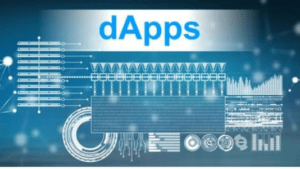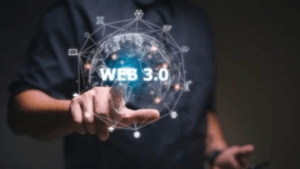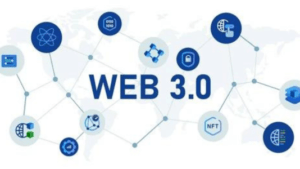Understanding Web 3.0:
- 1.1. The Evolution of the Internet: A Brief Recap
- 1.2. The Promise of Web 3.0
- 1.3. Key Pillars of Web 3.0: Decentralization and Interoperability
Decentralization: Redefining Trust and Ownership:
- 2.1. Blockchain Technology and Web 3.0
- 2.2. Eliminating Central Authorities
- 2.3. Enhancing Privacy and Security
- 2.4. Examples of Decentralized Applications (DApps)
Interoperability: Connecting Siloed Networks:
- 3.1. The Challenge of Siloed Data and Applications
- 3.2. Semantic Web and Interoperable Data
- 3.3. Creating a Seamless User Experience
- 3.4. Use Cases of Interoperability
Democratization of Internet Access and Governance:
- 4.1. Web 3.0 and Digital Inclusion
- 4.2. Empowering Individuals and Communities
- 4.3. Web 3.0 and Decentralized Governance Models
- 4.4. Case Studies in Democratization
Tokenization and Cryptoeconomics:
- 5.1. Digital Assets and Tokenization
- 5.2. Cryptoeconomics: Incentivizing Network Participation
- 5.3. New Economic Models and Funding Mechanisms
- 5.4. Tokenization Examples
Web 3.0 and the Future of Industries:
- 6.1. Finance and Banking
- 6.2. Healthcare
- 6.3. Supply Chain Management
- 6.4. Social Media and Content Creation
- 6.5. Education
- 6.6. Examples of Industry Transformations
Challenges and Considerations:
- 7.1. Scalability and Performance
- 7.2. User Experience and Adoption
- 7.3. Regulatory and Legal Considerations
- 7.4. Privacy and Security Challenges
- 7.5. Overcoming Challenges: Collaborative Efforts
- Conclusion:
Understanding Web 3.0:
- 1.1. The Evolution of the Internet: A Brief Recap
The internet’s journey began with Web 1.0, a static and read-only web where users primarily consumed information. Web 2.0 ushered in the era of user-generated content, social networking, and interactive web applications. It empowered users to become content creators and contributed to the rise of platforms like Facebook, YouTube, and Twitter. However, Web 2.0 also gave rise to centralized power structures and data silos, raising concerns about privacy, security, and control over personal data.
- 1.2. The Promise of Web 3.0
Web 3.0 aims to address the limitations of its predecessors by leveraging emerging technologies like blockchain, decentralized protocols, and artificial intelligence. It envisions an internet that is more decentralized, secure, private, and user-centric. Web 3.0 seeks to create an internet where individuals have greater control over their data, identity, and online experiences.
- 1.3. Key Pillars of Web 3.0: Decentralization and Interoperability
At the heart of Web 3.0 are two key pillars: decentralization and interoperability. Decentralization eliminates the need for central authorities, shifting control to distributed networks and consensus algorithms. Interoperability focuses on enabling seamless connectivity and data exchange between different applications, platforms, and systems.
Decentralization: Redefining Trust and Ownership:
- 2.1. Blockchain Technology and Web 3.0
Blockchain technology lies at the core of Web 3.0, enabling decentralized and trustless systems. Blockchain provides a transparent, tamper-proof, and immutable ledger that can be used for various applications, including cryptocurrency transactions, supply chain management, and decentralized identity systems.
- 2.2. Eliminating Central Authorities
Web 3.0 challenges the traditional notion of central authorities that control and monetize user data. Decentralized platforms and protocols distribute power among network participants, enabling individuals to retain ownership and control over their data.
- 2.3. Enhancing Privacy and Security
Web 3.0 introduces privacy-enhancing technologies like zero-knowledge proofs and decentralized identity systems. These technologies give users greater control over their personal information, reducing the reliance on centralized entities and minimizing the risk of data breaches and unauthorized access.
- 2.4. Examples of Decentralized Applications (DApps)
Decentralized applications, or DApps, are one of the key manifestations of Web 3.0. These applications leverage blockchain and other decentralized technologies to enable peer-to-peer interactions, automated smart contracts, and transparent governance. Examples include decentralized finance (DeFi) platforms, decentralized social media networks, and decentralized storage solutions.
Interoperability: Connecting Siloed Networks:
- 3.1. The Challenge of Siloed Data and Applications
The current internet landscape is characterized by siloed data and applications that operate in isolation. Web 3.0 seeks to overcome these limitations by promoting interoperability, allowing data and applications to seamlessly communicate and interact.
- 3.2. Semantic Web and Interoperable Data
The semantic web plays a crucial role in achieving interoperability. By structuring data in a machine-readable format, the semantic web enables intelligent data discovery, integration, and interpretation. This allows different applications and systems to understand and utilize data from diverse sources.
- 3.3. Creating a Seamless User Experience
Interoperability leads to a more cohesive and seamless user experience. Users can navigate seamlessly between different applications and platforms, with their data and preferences traveling with them. This results in a more personalized and tailored internet experience.
- 3.4. Use Cases of Interoperability
Interoperability has wide-ranging applications, such as cross-chain communication in blockchain networks, seamless integration of healthcare data for better patient care, and the creation of decentralized marketplaces that connect buyers and sellers across various platforms.
Democratization of Internet Access and Governance:
- 4.1. Web 3.0 and Digital Inclusion
Web 3.0 has the potential to bridge the digital divide and ensure equal access to the internet for all. By removing intermediaries and reducing costs, Web 3.0 enables individuals in underserved communities to participate in the digital economy.
- 4.2. Empowering Individuals and Communities
Web 3.0 empowers individuals by giving them control over their digital identities, enabling micropayments for content creators, and allowing for decentralized social networks. Communities can also leverage Web 3.0 to govern themselves and make collective decisions through decentralized governance models.
- 4.3. Web 3.0 and Decentralized Governance Models
Decentralized governance models, enabled by blockchain technology, allow participants to collectively make decisions and govern the platforms they use. These models promote transparency, inclusivity, and fairness, reducing the influence of centralized entities.
- 4.4. Case Studies in Democratization
Projects like Akash Network, which provides decentralized cloud computing, and Kleros, a decentralized arbitration protocol, showcase the potential of Web 3.0 in democratizing access to computing resources and dispute resolution.
Tokenization and Cryptoeconomics:
- 5.1. Digital Assets and Tokenization
Web 3.0 introduces the concept of digital assets and tokenization, where real-world assets or digital creations are represented and traded on blockchain networks. Tokens provide ownership, transferability, and programmability, enabling new economic models and incentives.
- 5.2. Cryptoeconomics: Incentivizing Network Participation
Cryptoeconomics leverages economic incentives to motivate network participants to contribute resources and maintain the integrity of decentralized systems. Token economies encourage active involvement, fostering a collaborative and self-sustaining ecosystem.
- 5.3. New Economic Models and Funding Mechanisms
Web 3.0 enables alternative funding mechanisms such as Initial Coin Offerings (ICOs) and Decentralized Autonomous Organizations (DAOs). These models offer new opportunities for startups and projects to raise capital and engage with their communities.
- 5.4. Tokenization Examples
Projects like Augur, a decentralized prediction market, and NBA Top Shot, a blockchain-based digital collectibles platform, demonstrate the potential of tokenization in creating new markets and unlocking value in previously illiquid assets.
Web 3.0 and the Future of Industries:
- 6.1. Finance and Banking
Web 3.0 has the potential to revolutionize the financial industry by providing decentralized, peer-to-peer financial services, enabling frictionless cross-border transactions, and empowering individuals with financial sovereignty.
- 6.2. Healthcare
Interoperable health records, decentralized clinical trials, and incentivized health data sharing are some of the ways Web 3.0 can transform the healthcare industry, improving patient outcomes and facilitating medical research.
- 6.3. Supply Chain Management
Web 3.0 can enhance supply chain transparency, traceability, and efficiency by leveraging decentralized ledger technology. It enables secure tracking of goods, eliminates counterfeit products, and streamlines cross-border logistics.
- 6.4. Social Media and Content Creation
Web 3.0 offers alternatives to centralized social media platforms, allowing users to have control over their data, monetize their content, and participate in decentralized communities. It promotes censorship resistance and empowers content creators.
- 6.5. Education
Web 3.0 can revolutionize education by providing decentralized learning platforms, enabling micro-credentials and lifelong learning, and fostering global collaboration among students and educators.
- 6.6. Examples of Industry Transformations
Projects like MakerDAO, which provides decentralized stablecoin issuance, and Filecoin, a decentralized storage network, demonstrate the transformative potential of Web 3.0 in the finance and storage industries, respectively.
Challenges and Considerations:
- 7.1. Scalability and Performance
Web 3.0 faces challenges related to scalability and performance, as decentralized systems often struggle to match the speed and capacity of centralized counterparts. Ongoing research and development aim to address these limitations.
- 7.2. User Experience and Adoption
To achieve widespread adoption, Web 3.0 needs to offer a seamless and intuitive user experience that rivals or surpasses centralized alternatives. User-friendly interfaces and educational initiatives can bridge the gap between the complexity of underlying technologies and user understanding.
- 7.3. Regulatory and Legal Considerations
Web 3.0 introduces novel legal and regulatory challenges, such as jurisdictional issues, smart contract enforceability, and data privacy. Policymakers need to strike a balance between innovation and consumer protection, fostering a supportive regulatory environment.
- 7.4. Privacy and Security Challenges
While Web 3.0 aims to enhance privacy and security, it also introduces new challenges. The transparent nature of blockchain raises concerns about data confidentiality, and the potential for smart contract vulnerabilities requires robust security measures.
- 7.5. Overcoming Challenges: Collaborative Efforts
Addressing the challenges associated with Web 3.0 requires collaboration among technologists, policymakers, industry leaders, and users. Open dialogue, standards development, and iterative improvements will pave the way for a successful transition to Web 3.0.
Conclusion:
Web 3.0 represents a paradigm shift that promises to redefine the internet landscape in profound ways. By leveraging the principles of decentralization, interoperability, and user empowerment, Web 3.0 offers a more inclusive, secure, and efficient internet ecosystem. The examples presented throughout this article demonstrate the transformative potential of Web 3.0 across various industries and applications. However, challenges remain, and the successful implementation of Web 3.0 requires collaborative efforts from technology innovators, policymakers, and users alike. As we navigate the path to Web 3.0, it is essential to consider the societal, economic, and ethical implications, ensuring a future internet that benefits all.



